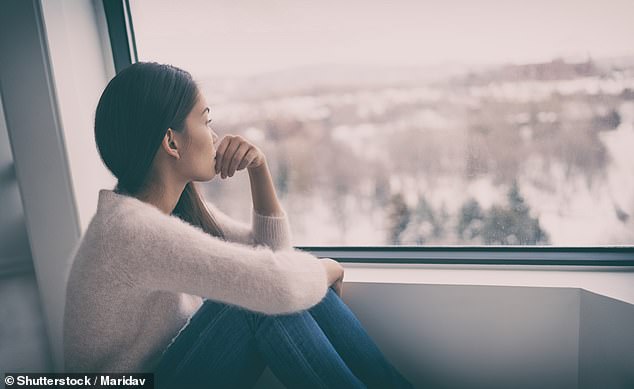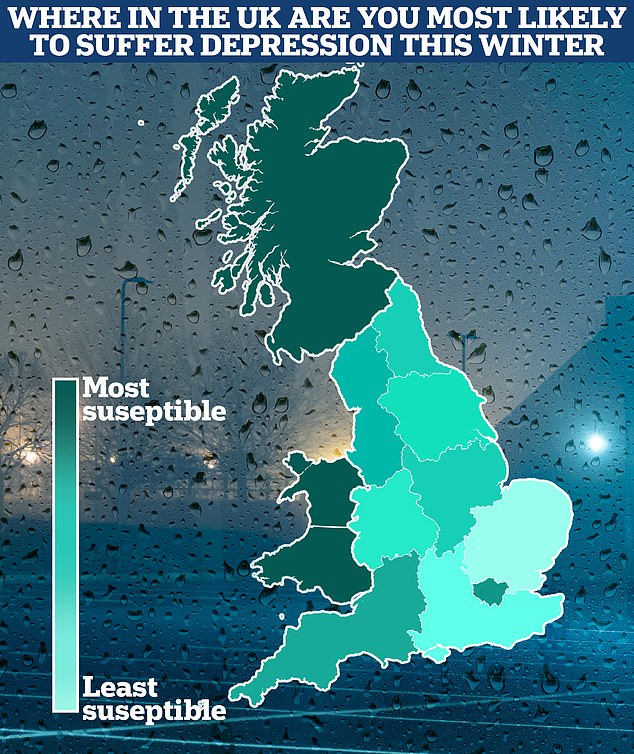Longer nights, gloomy skies and less sunshine are a reality here in Britain and, for many, this can lead to moodiness, drowsiness and cravings for comfort food.
While many of us feel a little down in the colder months, for some people these feelings can be particularly acute and may be a sign of a condition known as seasonal affective disorder (SAD).
SAD. Also known as the “winter blues” or “winter blues”, it is thought to affect up to a third of British adults.
Although scientists do not yet fully understand the condition, it is thought to be caused by serotonin imbalances and alterations in the biological clock are thought to contribute.
Unsurprisingly, regions with fewer hours of sunlight in winter, such as Scotland and Wales, report higher levels of SAD-related symptoms.
But London, a city that receives considerably more hours of sunshine than climates further north, was revealed to be one of the worst places in England to develop symptoms associated with the disorder.
Regions with fewer hours of sunlight in winter, such as Scotland and Wales, report higher levels of SAD-related symptoms, according to ONS and Met Office data collected by laboratory testing company York Test.
In the findings, produced by laboratory testing company York Test, researchers examined data from the Met Office to find the average number of hours of sunlight per UK region during the winter months.
They then combined this with data from the Office for National Statistics which tracks rates of mental wellbeing in these regions using a 35-point scale, as well as separate questionnaires and surveys that track specific topics such as depression and anxiety.
When this data was combined, the team found that Scotland, as well as north and south Wales, were the most susceptible to SAD.
The fourth most susceptible place was London, followed by the south-west of England, which came in fifth place.
Experts said London may rank so high due to its higher anxiety levels, which are recorded at 64.4 per cent, the highest of all regions, making it a more stressful place to live in. general.
This is despite the fact that the inhabitants of the capital enjoy an average of 62 hours of sunshine per month in winter. That’s 21 hours more sunshine than Scotland.
In contrast, the least susceptible to SAD locations surveyed were the east and south-east of England.
The area with the lowest overall mental wellbeing score was the North East, at 24.84 per cent, compared to the East, which scored 25.5 per cent.
Psychologist and SAD sufferer Dr Pam Spurr spoke on the BBC Radio London about the condition, describing it as a “difficult journey” for many people.
He explained that the disorder is caused by a biological imbalance of melatonin, a hormone that helps regulate the body’s sleep-wake cycles, which produces the symptoms of SAD, such as tiredness, lethargy and bad mood.
“Sunlight disrupts (melatonin) production naturally, so when there is less sunlight in the fall and winter, patients do not see their melatonin production diminished,” he said on a radio show last fall.
He added that many patients also suffer from low levels of serotonin, the brain chemical that can make you happy.
But he explained that cities like London can worsen SAD symptoms, such as anxiety and bad mood.
‘I think it gets worse when you’re experiencing something like SAD and you’re in a bustling city and you just feel isolated because you feel like you don’t have the energy to go out there. You just feel like you want to hunker down and eat comfort food, which is another characteristic,” Dr. Spurr said.
While scientists do not yet fully understand the full mechanics of SAD, the NHS explains that a lack of sunlight compared to summer can interfere with the body’s internal clock and trigger its symptoms.

The NHS explains that a lack of sunlight can interfere with the body’s internal clock, which can lead to SAD symptoms.
For example, the body uses sunlight exposure for time functions, such as waking up, so lower light levels in the morning put the body’s internal rhythm in conflict with the alarm clock.
This despite the fact that you wake up at the same time as in the summer.
Treatment for SAD includes lifestyle measures, such as making sure you get natural sunlight, exercising, and managing stress levels. The NHS also suggests using a light box (a very bright lamp that mimics outside light) and even taking antidepressants and counselling.
Dr Jon Van Niekerk, chair of the adult general faculty at the Royal College of Psychiatrists, said SAD was a well-observed problem during the autumn and winter.
“There are several things people can do to feel better if they suspect they may have SAD,” she said.
‘This includes going for walks during the day, exercising regularly and talking to friends and family about how they are feeling.
‘There is a significant difference between feeling depressed and suffering from a mental illness such as depression. Anyone who thinks they might need professional help should see their GP.’

